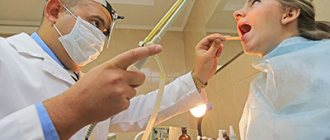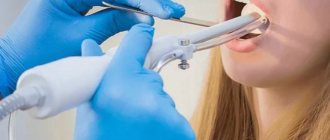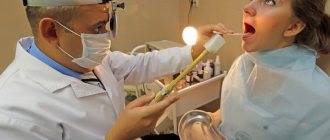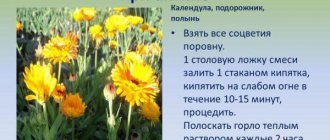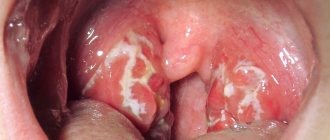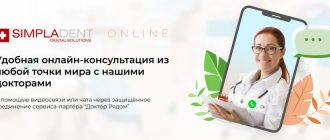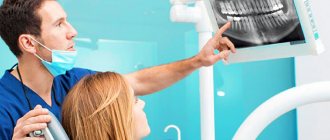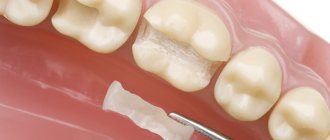What are lacunae
The tonsils are covered on the outside with a mucous membrane with depressions called lacunae. They protect the body from pathogens and ensure filtration of everything that enters the mouth.
In the follicles that make up the tonsils, lymphocytes mature and are released onto the surface of the lacunae to destroy microbes. In a healthy person, the lacunae cleanse themselves.
Why is rinsing prescribed?
When immunity decreases, the production of lymphocytes decreases, and an inflammatory process begins in the lacunae. As a result of the disease, the ability to cleanse itself decreases and the recesses of the tonsils become clogged with purulent plugs.
The person’s health deteriorates and the following appears:
- heat,
- severe sore throat
- difficulty swallowing.
With frequent such manifestations, doctors diagnose chronic tonsillitis. And rinsing is prescribed to prevent the spread of infection to other organs.
This stops the exacerbation of tonsillitis and in some cases eliminates the need for surgical intervention to remove the tonsils. Washing is almost painless, as doctors use modern equipment to carry it out quickly.
Important! It is dangerous to clean lacunae on your own due to the risk of damaging the delicate mucous membrane of the palate and pharynx.
Side effects from rinsing
Rinsing the tonsils can cause discomfort to the patient both during the process and after completion of the procedure. You need to be prepared for the following unpleasant manifestations:
- Damage to the mucous membrane at the treatment site. In this case, it is painful for a person to swallow, especially solid food, although chronic tonsillitis implies a sore throat in itself. The pain should decrease within 24 hours after the first procedure. If the pain increases, consult your doctor.
- Exacerbation of the disease: rise in temperature, weakness, swelling of the lymph nodes. This reaction may occur due to decreased immunity. In this case, you need to decide whether to continue the course of rinsing procedures.
- Allergy to the components of the medicinal solution. In this case, hypersensitivity and redness develop at the site of exposure, spreading to nearby areas. The doctor should notice such a reaction and replace the remedy.
Seeing a doctor in a timely manner will help maintain your health.
Don't delay treatment, call right now. We work around the clock. tel. (24 hours a day)
Types of washing
Purpose of appointment: to remove pus from the lacunae and treat them with a drug. After this, the patient's condition improves significantly.
Specialists carry out the procedure in different ways:
syringe. A solution is drawn into a 20-gram syringe. Instead of a needle, a special nozzle with a curved end is put on so that the solution falls directly on the stopper. The liquid under the pressure of the piston is fed into the lacuna and flushes it.
Washing the tonsils- Vacuum method of washing tonsils . The tonsils are anesthetized, a vacuum suction cup is attached to them, through which the purulent contents are pumped out. After this, the medicinal composition is pumped into the lacuna.
- Ultrasonic washing of tonsils . The cleaning principle is based on a combination of cavitation and ultrasound. Air bubbles form in the washing liquid, and when they rupture, the membranes of microbial cells are damaged.
The Kuntsevo Medical Center has modern otolaryngological equipment, which allows the operation to be performed as quickly, efficiently and painlessly as possible.
Washing methods
Flushing using a syringe
This is the simplest and therefore popular method. It can be carried out in a regular clinic or even at home. A syringe with a curved cannula is taken, onto which a blunt needle is placed. A medicinal solution is drawn up with a syringe, which is injected into the lacuna using a needle. And under pressure, mechanical removal of pus occurs.
The procedure is repeated several times. The patient spits the mixture of medicine and purulent discharge. At the end of the procedure, the tonsils are treated with an antiseptic solution.
If you wash the lacunae of the palatine tonsils at home, you must follow the following algorithm:
- draw an antiseptic solution into a syringe without a needle;
- pre-treat the tonsils with Lugol's solution or Miramistin;
- if possible, open your mouth as wide as possible and breathe deeply through your mouth;
- pressing on the syringe plunger, direct the stream at the plugs, trying to wash out the pus;
- spit out liquid with pus:
- rinse your mouth.
If nausea and vomiting occur, rinsing should be stopped.
Syringe rinsing has a number of disadvantages:
- the diameter of the needle does not always make it possible to rinse small gaps;
- pus can, instead of discharge outward, on the contrary, penetrate even deeper;
- there is a high probability of injury to the tonsils, especially if you do rinsing at home.
Vacuum rinsing
The value of this method:
- Vacuum cleansing of even deep sections of lacunae;
- the likelihood of pus getting onto unaffected surfaces is minimal;
- Ultrasound is additionally used to inject the medicine into the tonsils;
- The Tonsillor device, through which rinsing is performed, is quite easy to use.
Technique for performing the procedure:
- the patient sits in a chair with his mouth wide open;
- anesthetize the tonsils with local anesthetics (to suppress the gag reflex);
- a vacuum suction cup is placed on the tonsil and the pus is sucked out through a special tube;
- evacuation lasts about 10 seconds, during which you must hold your breath;
- Then the nozzle is changed, and with the help of ultrasound the medicine is delivered deep into the lacuna.
The procedure must be repeated 7-10 times.
This method is more effective, but its cost is higher.
After the procedure, a sore throat and redness may sometimes occur. In rare cases, the temperature rises. In this case, it is necessary to suspend treatment and wait until the patient’s condition normalizes.
Washing with a device combining cavitation and ultrasound
For this purpose, the UZOL device is used. The principle of operation is as follows: ultrasound causes vibrations in the liquid, resulting in the formation of air bubbles (this is called cavitation). Then the bubbles burst, a shock wave is formed, through which the bacterial membrane is damaged, followed by their death. The pathological contents of the lacunae liquefy and come out.
Then, also with the help of ultrasound, the medicine is injected deep into the tonsil.
The technique for performing the procedure is similar to the previous ones:
- the patient sits with his mouth open;
- the doctor uses a spatula to push the root of the tongue down;
- the UZOL device, which looks like a pistol, is inserted into the oral cavity;
- the patient exhales and the stream is directed to the tonsils;
- The leaking liquid should be spat out.
The procedure lasts approximately 5 minutes.
The price of the method is also slightly higher than usual.
How is the procedure performed?
All rinsing methods are based on exposing the tonsils to a stream of disinfecting solution or vacuum. Cleaned tonsils are treated with medications.
Processing each tonsil takes from 30 seconds to 1.5 minutes. The time depends on the choice of type of cleaning of the lacunae and the depth of damage to the lacunae.
Important! Before the procedure, you cannot eat for 1.5-2 hours. This is due to the fact that rinsing provokes a gag reflex.
To prevent possible discomfort, the doctor treats the tonsils with a local anesthetic with lidocaine or novocaine in the form of a spray.
Procedure methods
If plaque appears on the tonsils, you should contact an otolaryngologist. During the initial examination, the doctor makes a diagnosis and determines the extent of the lesion. Based on the results obtained, the specialist selects the optimal technique, which is aimed at clearing the gaps from the accumulation of pathogenic microorganisms.
In accordance with the degree of damage to angina, as well as depending on the characteristics of the patient’s body, the optimal method of rinsing is selected:
- Hardware. Vacuum equipment works in a special way - it operates on the principle of a vacuum cleaner. The device collects pathogenic contents from the lacunae, clearing the larynx area. Thanks to the effects of ultrasound, the inflammatory process is “extinguished” by reducing pathogenic manifestations. Radiation promotes the penetration of the antiseptic solution used into the deep layers of tissue.
- Using a syringe. A cannula with a brass rod is attached to the syringe. The deep part of the throat is treated. The patient is required to remain in a stationary position with his mouth wide open.
Procedures last up to 10 minutes. Liquid is pumped out of the lacunae. This is necessary to ensure guaranteed cleansing of purulent plugs, as well as food debris, pathogenic microorganisms and waste products of dangerous bacteria.
Flushing with a syringe
The time-tested mechanical method significantly reduces the cost of treating the affected area. Most often used for children.
Benefits of flushing with a syringe:
- an accessible method of getting rid of pathogens;
- minimal number of contraindications;
- persistent therapeutic effect.
During the procedure, local antibacterial and antiseptic agents are used, which act locally - exclusively on the inflamed area. This approach eliminates the development of allergic reactions and various complications characteristic of oral antibiotics.
Hardware method
Vacuum washing allows you to achieve a more sustainable effect when compared with the previous method. The hardware method is most often used for teenagers.
The procedure is contraindicated in the following cases:
- more acute infectious disease, which is accompanied by elevated body temperature;
- a history of cancer;
- tuberculosis.
Among the relative indications, an increased gag reflex should be highlighted. In this case, the procedure cannot be performed.
Contraindications
Treatment of lacunae is not prescribed for patients with:
- exacerbation of other chronic diseases, including caries;
- cancer diagnoses;
- in the 1st and 3rd trimester of pregnancy;
- pathology of the retina;
- severe pathologies of the heart and blood vessels;
- up to 3 years of age.
For hypertension, consultation with a specialized specialist is required.
Important! It is necessary to warn the doctor about any existing individual intolerance to drugs.
Recommendations after procedures
Rinsing the lacunae of the tonsils is a physical effect on the inflamed tissue, so after cleansing, discomfort and mild pain are possible.
You cannot eat immediately after the procedure, the first meal should not be earlier than 30 minutes later. It is necessary to regularly gargle with miramistin, furatsilin solution, infusion of chamomile, oak bark.
Washing the tonsils is not a very pleasant procedure, but it is done quickly. Its effectiveness has been proven by many years of use for the relief of chronic tonsillitis.
Means for washing tonsils
In principle, any antiseptic solution is suitable. Its main characteristics should be the following:
- non-toxic if swallowed;
- chemically neutral so as not to cause burns to the mucous membrane;
- has a bactericidal effect, especially on streptococci and staphylococci - the main pathogens of tonsillitis. It’s not bad if the solution also has antiviral and antifungal effects;
- the temperature of the solution used should be about 37°C.
The most commonly used solution is Furacilin, as well as Chlorhexidine, Miramistin, and various bacteriophages. At the end of the procedure, the tonsils are treated with Lugol's solution. At home, rinsing with a decoction of herbs (sage or chamomile) is recommended.
